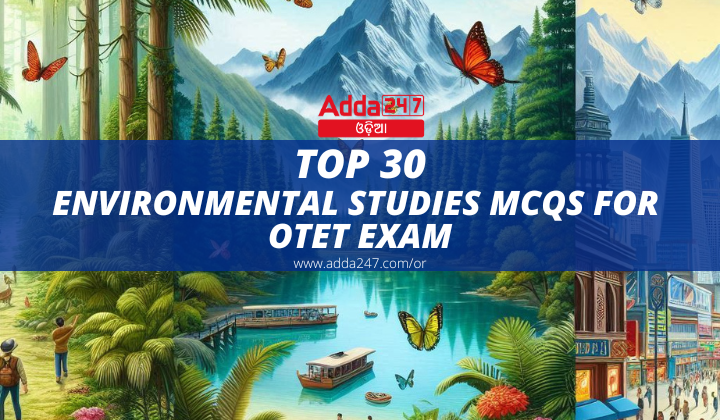The top 30 Environmental Studies MCQs for the OTET exam are tailored to help aspiring teachers grasp essential environmental concepts and issues. These questions delve into topics such as biodiversity, conservation, pollution, climate change, and sustainable development. By focusing on both theoretical knowledge and practical applications, this set of MCQs aims to equip candidates with a comprehensive understanding of environmental science, crucial for educating future generations. The carefully curated questions ensure that candidates are well-prepared to tackle the environmental studies section of the OTET exam with confidence and proficiency.
Top 30 Environmental Studies MCQS For OTET Exam
- Which national park in India has a climate that varies from tropical to subtropical, temperate, and even arctic?
[A] Kanha National Park
[B] Jim Corbett National Park
[C] Bandipur National Park
[D] Namdapha National Park
Correct Answer: D - In which state is the Pushpagiri Wildlife Sanctuary located?
[A] Kerala
[B] Karnataka
[C] Andhra Pradesh
[D] Goa
Correct Answer: B - Which of the following was India’s first Biosphere Reserve?
[A] Sunderbans
[B] Nanda Devi
[C] Nilgiri
[D] Pachmarhi
Correct Answer: C - The Gautam Buddha Wildlife Sanctuary is located in which states?
[A] Bihar and Jharkhand
[B] Bihar and Uttar Pradesh
[C] Uttar Pradesh and Jharkhand
[D] West Bengal and Jharkhand
Correct Answer: A - Karnal Bunt primarily affects which of the following crops?
[A] Rice
[B] Wheat
[C] Maize
[D] Bajra
Correct Answer: B - Which country leads the world in clean energy investment?
[A] USA
[B] China
[C] Japan
[D] Germany
Correct Answer: B - Approximately what fraction of the world’s mangrove vegetation is found in India?
[A] 3%
[B] 6%
[C] 9%
[D] 12%
Correct Answer: A - Along with Jatropha, which plant’s seed oil is used as feedstock for biodiesel?
[A] Arachis hypogea
[B] Pongamia pinnata
[C] Butea monosperma
[D] Pterocarpus santalinius
Correct Answer: B - The Madhav Gadgil Panel suggested listing which region as an Ecologically Significant Area (ESA)?
[A] Eastern Ghats
[B] Western Ghats
[C] Both 1 & 2
[D] Eastern Himalayas
Correct Answer: B - Which statement best describes “Embodied Energy” (EE)?
[A] Energy used in the maximum useful work possible
[B] All energy used in the construction process
[C] Total flow of energy through ecological systems
[D] None of the above
Correct Answer: B - Which of the following is an important strategy for the conservation of biodiversity?
[A] Wildlife Sanctuaries
[B] National Parks
[C] Botanical Gardens
[D] Biosphere Reserves
Correct Answer: D - Which tree is considered to be an environmental hazard?
[A] Eucalyptus
[B] Babool
[C] Neem
[D] Amaltas
Correct Answer: A - The greenhouse effect is mostly caused by which gas?
[A] Ozone layer
[B] Moisture in the atmosphere
[C] Infra-red radiation
[D] Carbon dioxide in the atmosphere
Correct Answer: D - “Agenda 21” was adopted by which event?
[A] Kyoto Protocol
[B] Montreal Protocol
[C] Summit on Sustainable Development
[D] First Earth Summit
Correct Answer: D - Which of the following is not a greenhouse gas?
[A] Nitrogen
[B] Methane
[C] Nitrous oxide
[D] Carbon dioxide
Correct Answer: A - Which source of electricity is considered best for sustainable development in India?
[A] Atomic energy
[B] Coal
[C] Mineral oil and gas
[D] Hydroelectricity
Correct Answer: D - The increase in which gas due to fossil fuel use is a major environmental concern?
[A] Argon
[B] Carbon dioxide
[C] Ozone
[D] Nitrogen
Correct Answer: B - The Ramsar Convention is associated with the conservation of what type of area?
[A] Wetlands
[B] Drylands
[C] Forests
[D] Biofuels
Correct Answer: A - Where does the greatest diversity of animal and plant species occur?
[A] Equatorial forests
[B] Deserts and Savanna
[C] Temperate deciduous forests
[D] Tropical moist forests
Correct Answer: A - In a food chain, what percentage of solar energy is typically utilized by plants?
[A] 1.0%
[B] 10%
[C] 0.01%
[D] 0.1%
Correct Answer: A - The transitional zone between two distinct communities is called what?
[A] Ecotone
[B] Ecotype
[C] Ecade
[D] Ecosphere
Correct Answer: A - Which of the following is not an endangered bird in India?
[A] Forest Owlet
[B] Mallard
[C] Great Indian Bustard
[D] White-bellied Heron
Correct Answer: B - Which forest type extends from Kashmir to Arunachal Pradesh between 2900 to 3500 meters?
[A] Montane Wet Temperate Forests
[B] Himalayan Dry Temperate Forest
[C] Sub-Alpine Forest
[D] Moist Alpine Scrub
Correct Answer: C - What are the impacts of grazing on grasslands?
[A] Only 1 & 2
[B] Only 2 & 3
[C] Only 1 & 3
[D] 1, 2 & 3
Correct Answer: D
Options:
Quality of grasslands deteriorates rapidly.
Mulch cover of the soil reduces.
Microclimate becomes more dry and is invaded by xerophytic plants and burrowing animals. - Which species are found in cold desert regions?
[A] Only 1, 2 & 3
[B] Only 2, 3 & 4
[C] Only 1, 2 & 4
[D] 1, 2, 3 & 4
Correct Answer: C
Options:
Asiatic Ibex
Lion Tailed Macaque
Black Necked Crane
Snow Leopard - Which statements about dissolved oxygen are correct?
[A] Only 1 & 2
[B] Only 2 & 3
[C] Only 1 & 3
[D] 1, 2 & 3
Correct Answer: C
Options:
Dissolved oxygen escapes through the air-water interface and respiration.
Retention of dissolved oxygen is not influenced by temperature.
Aquatic organisms die if dissolved oxygen levels fall below 3-5 ppm.
Pollution and Environmental Hazards - What is the primary cause of acid rain?
A] Ozone
[B] Sulfur dioxide and nitrogen oxides
[C] Carbon monoxide
[D] Methane
Correct Answer: B - Which statement best describes bioaccumulation?
[A] Accumulation of substances, such as pesticides, in an organism
[B] Increase in agricultural yield through modern techniques
[C] Gradual accumulation of pollutants in water bodies
[D] Natural decomposition of organic matter
Correct Answer: A - Which gas is primarily responsible for the depletion of the ozone layer?
[A] Carbon dioxide
[B] Methane
[C] CFCs (Chlorofluorocarbons)
[D] Nitrous oxide
Correct Answer: C - Eutrophication primarily results from the over-enrichment of water with what?
[A] Oxygen
[B] Carbon dioxide
[C] Nutrients (like nitrogen and phosphorus)
[D] Salts
Correct Answer: C










